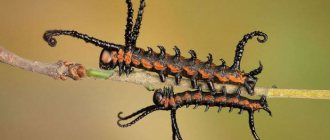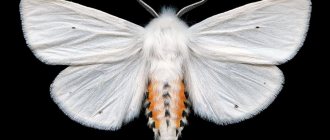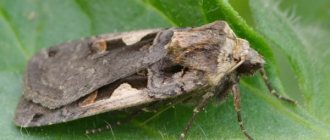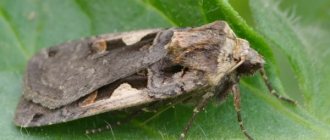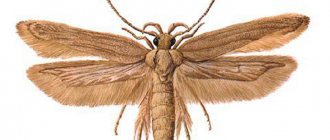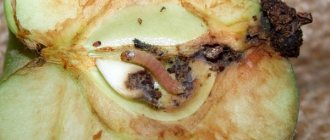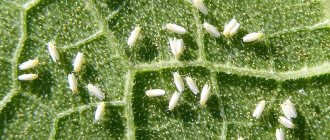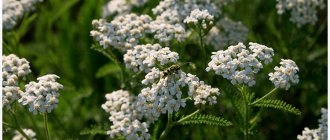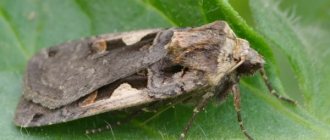The cabbage weed, also known as cabbage grass, is a dangerous pest of garden crops. He enjoys eating horseradish, rutabaga, turnips, turnips, radishes, but most of all cabbage. How to get rid of cabbage whites along with all its larvae and caterpillars?
As children, we could not even think that such a cute creature as the cabbage white is actually a dangerous pest of garden crops, mostly, of course, cabbage. And with the appearance of a dacha in the lives of each of us, we, who have matured, certainly choose the latter between admiring the white grass and preserving the cabbage.
The cabbage butterfly is distributed throughout Eastern Europe, as well as North Africa and parts of Asia.
What does a cabbage butterfly look like?
The cabbage white butterfly is a small butterfly, the length of which reaches 3.8-5 cm. The wings of this butterfly are white, their upper part at the corners is edged with a black border, there are also two small black spots in the middle of the hind wings, at the top. Females are distinguished by the presence of two spots on the underside of the forewings. The underparts of the wings are yellow, with black pollen. The length of the fore wing of the imago ranges from 25 to 33 mm.
The adult feeds on the flowers of plants such as dandelion, alfalfa and greenweed.
Fruit tree pests
A well-kept garden with spreading trees is a source of pride for the owner. To a large extent, the sanitary condition of the entire dacha plot depends on the health of the fruit trees. Many butterflies lay eggs on their bark; larvae overwinter in the crevices of trunks and cracks, which spread throughout the dacha in the spring.
codling moth
Large butterfly of light gray color. Her body and wings are decorated with black wavy lines. The width of the butterfly with fully opened wings reaches 18-24 mm. The individual is nocturnal and lays eggs (100-600 pieces each) after the apple trees have flowered.
Adult caterpillars overwinter on the soil. In early spring (air temperature should not be lower than +10°C) pupation occurs. After 2-3 weeks, a butterfly emerges from the golden-brown pupa. The mass flight of the codling moth lasts from May to September. In warm autumn temperatures (above +20°C), caterpillars can pupate in September-October.
During the summer season, two generations (clutches) of the codling moth have time to mature into adult butterflies. The first generation can damage about 20% of apples. But butterflies of the second generation of the codling moth already spoil 80-90% of the harvest. They fly out before the end of their “big sisters” years.
Plum moth
Large gray-brown butterfly (body length - 12-15 mm). Its wings have a purple tint, and their span reaches 10-15 mm. Butterflies lay eggs (40-45 eggs) on the back of leaves or near the petioles of plums. After 8-10 days, white caterpillars are born from translucent greenish eggs. Over time, their long bodies acquire an intense red color.
Young caterpillars feed on the pulp of ripe plums or eat the soft stone of still green fruits. They almost always gnaw the stalk, which deprives the fruit of water and nutrients. Caterpillars that survive the winter pupate in April and after 15-33 days (depending on the climate zone) the butterfly flight begins.
Ringed silkworm
Yellow-brown butterflies with a wingspan of 30-40 mm. Females lay ring clutches of 400 eggs each. Insects fly out at night, and during the day they gather in groups in the upper branches of the crown.
Caterpillars eat greens within 25-40 days. After spending 14-16 days in the pupal stage, a new generation of ringed silkworm butterflies begins.
Goldentail
A medium-sized, completely pubescent butterfly with dazzling white wings. On the abdomen of the female there are several tufts of golden fibers. In one clutch, on the back side of the leaf, there are 200-500 yellowish oval eggs. After 10-14 days, grayish-black caterpillars appear (length 30-40 mm). They are dotted with red lateral warts and have two orange spots on the back of the body.
Young caterpillars feed on fresh greenery, completely eating away the leaf of the tree. During the summer, caterpillars can change color 4-5 times. After living 4-5 instars, the caterpillars turn into a black and white pupa. Pupated caterpillars, in groups or individually, are wrapped for wintering in a sclerotized leaf wrapped in cobwebs. The cold resistance of lacewing pupae depends on the quality of nutrition in the caterpillar stage.
Interesting! The lacewing reproduces mainly in natural conditions (thickets of hawthorn, blackthorn, young oak forest belts). Light and furry tracks have excellent aerodynamic properties. They are picked up by the wind and transported over long distances. In nature, as in garden plots, caterpillars spend the winter on the upper branches of trees, being heat- and light-loving.
Wood corrosive
A large butterfly (body length - 45-50 mm), leading a nocturnal lifestyle. Its large translucent wings (up to 70 mm in the open position) and abdomen are strewn with black dots of various shapes and sizes. The female woodworm lays eggs on the bark of fruit trees (up to 300 pieces).
Two weeks later, pinkish-yellow caterpillars are born. They develop over two seasons and with age they lose their pink color and darken. Adult caterpillars (body length up to 60 mm) pupate, and butterflies appear in June-early July.
Grape (bunch) leaf roller
A light brown butterfly with an irregularly shaped olive-gray-brown pattern on the large upper wings (span - 10-20 mm). Over the course of two summer months (July-August), females lay eggs (60-140 eggs in one clutch) on the upper side of the grape leaf and generously cover the clutch with a layer of secretions, preventing drying out.
As the eggs mature, the color of the clutch changes from light green to dark yellow and almost black. After 5-10 days, gray-brown caterpillars appear (body length - 1.5 mm). They crawl along the leaf, trying to get to the woody parts of the plant. They make nests there and spend the winter, withstanding frosts down to -20-25°C.
After the spring buds appear, the caterpillars make their way inside and feed on the greens for 30-40 days. During this time, one caterpillar damages almost 40 ovaries, reducing the yield by 20-30%. The adult caterpillar, 2-3 cm long, is ready to pupate, and after 12-14 days the grape leaf roller butterfly emerges from a light chestnut cocoon.
Advice! The destruction of caterpillars can also be done in winter. Usually, nests are clearly visible on the vine, as well as on the stakes left over from the summer. They are generously moistened with solutions of Nitrofan or DNOC (sometimes the preparations are simply poured inside the exfoliated bark, which allows you to reach all the caterpillars). The grapes should be planted taking into account the regional wind rose. So that the row spacing is well ventilated (light caterpillars can tolerate a good draft).
Vertuna leaf
A motley black and gray butterfly with small wings (span - 9-11 mm). The female lays small yellow eggs (100-150 eggs per clutch) on the leaves, which are then entwined by the caterpillars that hatch after 14-15 days.
After wintering, the caterpillars crawl out of their nests and continue to feed until mid-summer. At the end of June-July they pupate. After two weeks, brown pupae (5 mm long) turn into butterflies.
hawthorn
White or light gray butterfly with large apron wings (span 50-65 mm). Thick black veins are clearly visible on their translucent surface. The female hawthorn lays 60-100 yellowish eggs on the upper side of the leaf.
After 14-17 days, ash caterpillars appear (body length 10-20 mm). Along the back and sides there are wide stripes of orange or dark brown colors. Each caterpillar braids and rolls up a leaf in which it grows and overwinters. With the onset of spring, mature caterpillars begin to eat away the buds. Adults (body length 45-50 mm) pupate in early May-June, and butterflies appear after 10-15 days.
American white butterfly
An individual with snow-white large wings (span - 25-35 mm). A white coating remains on the black antennae, and the translucent abdomen is densely covered with white hairs. The female white American butterfly lays 100-600 yellowish-green eggs with a blue tint. An individual of the first generation manages to make several clutches (up to 1500 eggs), the second - up to 2500 eggs.
After 10-15 days, furry caterpillars dotted with warts are born. During 40-45 days of their development, they change color 7-8 times and molt. Pupae overwinter in the surface layers of the soil, in the cracks of fences and fences, in withered grass or garbage. In mid-summer (July-August) butterflies appear.
How to deal with cabbage butterfly
There are several methods for controlling cabbage butterfly in your garden. Let's talk about the most effective of them.
Natural enemies
Wasps, including paper wasps, are excellent living assistants in the fight against the dangerous cabbage pest. Female wasps lay eggs in the caterpillars' bodies, and the hatched larvae subsequently feed on the caterpillars' bodies from the inside. Wasp wasps are especially dangerous for caterpillars.
Paper wasps are so named because they build their nests from paper, which they make themselves by chewing wood fibers and wetting them with their sticky saliva. The second name for paper wasps is social wasps.
There is an opinion that cabbage caterpillars are also eaten by birds, but this is not so. The caterpillar of this butterfly, when touched, immediately releases a toxic substance, and therefore the maximum that a bird can do is peck at the caterpillar, which, of course, will die as a result of this.
Collecting cabbage caterpillars by hand
Before you start collecting cabbage caterpillars, be sure to wear gloves!
It is still relevant to collect caterpillars and their larvae manually. Despite the scrupulousness of the method, it is still one of the most effective. Garden crops are inspected for the presence of parasites on the inside of the leaf. Cabbage caterpillars and larvae are collected and destroyed. The most humane way is to collect them in a plastic bottle, cap it and throw it away.
Experienced summer residents recommend using garden decoys to repel cabbage weeds. Immediately after planting the cabbage, install rods between the rows, on which place whole eggshells with a hole for the nozzle or inverted plastic cups. This will create the illusion that the space is occupied and will prevent the cabbage whites from laying eggs on your cabbage.
Insecticides and biological products - to help
Kinmiks, Fitoverm, Lepidocid, Bitoxibacillin, Decis Profi will help you in the fight against the cabbage butterfly. Don’t forget to treat cabbage against other pests: for this purpose, for example, preparations such as Aktara and Herold have been developed.
- Fungicide, insecticide and acaricide - what are these drugs and how to use them correctly
We understand the chemicals that are used in summer cottages to protect plants.
Folk remedies against caterpillars on cabbage
Cabbage butterflies look for plants to lay eggs by smell, and they can be disturbed by extraneous aromas, for example, basil, mint, dill, sage, marigold, fennel, chamomile. You can plant them next to the cabbage bed, between the rows, around the perimeter of the entire plot - they will not only bring benefits, but also decorate the area.
On a note! The smell of tomato and potato tops laid out between the rows near the plant will lead you astray. You can hang pieces of eggshells strung on a thread over the cabbage bed - they sway in the wind and resemble flying butterflies. This means the place is already taken.
Effective homemade remedies (used against butterflies, caterpillars, as a preventive measure):
- onion peels – peels (1 l) + hot water (2 l), leave in a closed container for ½ day, strain, spray before and during flight; Another option for use is to scatter near the cabbage;
- decoction of tomato and potato tops - dry (2 kg) or fresh tops (4 kg) + boiling water (5 l), leave for 4 hours, then put on low heat, simmer for 3 hours, keep covered for 24 hours, dilute with water before spraying 1 :1;
- ash - dust the plants, the soil under them, spray with infusion (0.5 liters of ash + 10 liters of water + ½ piece of crushed laundry or tar soap, stir, leave for 24 hours), repeat every 14 days;
- valerian solution – one pharmaceutical bottle of valerian + water (3 l), stir or 10-15 drops of fresh plant juice (leaves and stems are minced, squeezed out the juice, stored in the refrigerator for no more than a month) + water (10 l), spray the leaves ;
- black pepper decoction – peppercorns (25-30 g) + boiling water (1 l), boil, reduce heat, cook for 15 minutes, leave for three days in a closed container, then pour in water (5 l) + soap shavings (30-40 g ), carry out the procedure twice with an interval of 14 days (you can add 100 g of mustard powder to the decoction);
- decoction of hot pepper – chop fresh or dry pods (5 pieces) + water (3 l), bring to a boil, simmer over low heat for half an hour, cool, spray the leaves;
- vinegar essence – essence (2 tbsp) + water (10 l) + salt (2 tbsp), stir, spray in the evening or on a cloudy day so as not to burn the plant (instead of salt, you can add 25 g of ammonia);
- ammonia - ammonia (25 ml) + water (10 l), stir, spray the leaves from below and above;
- baking soda – sprinkle a mixture of baking soda powder and corn flour (1:1) under the cabbage, on the leaves;
- bay leaf - spread dry leaves near the cabbage, spray with infusion against butterflies (leaf (10 g) + boiling water (1 l), leave for 1 hour), repeat the procedure after five days;
- garlic infusion – crushed heads (10 pieces) + warm water (5 l), leave for three days, water the soil, spray the leaves.

